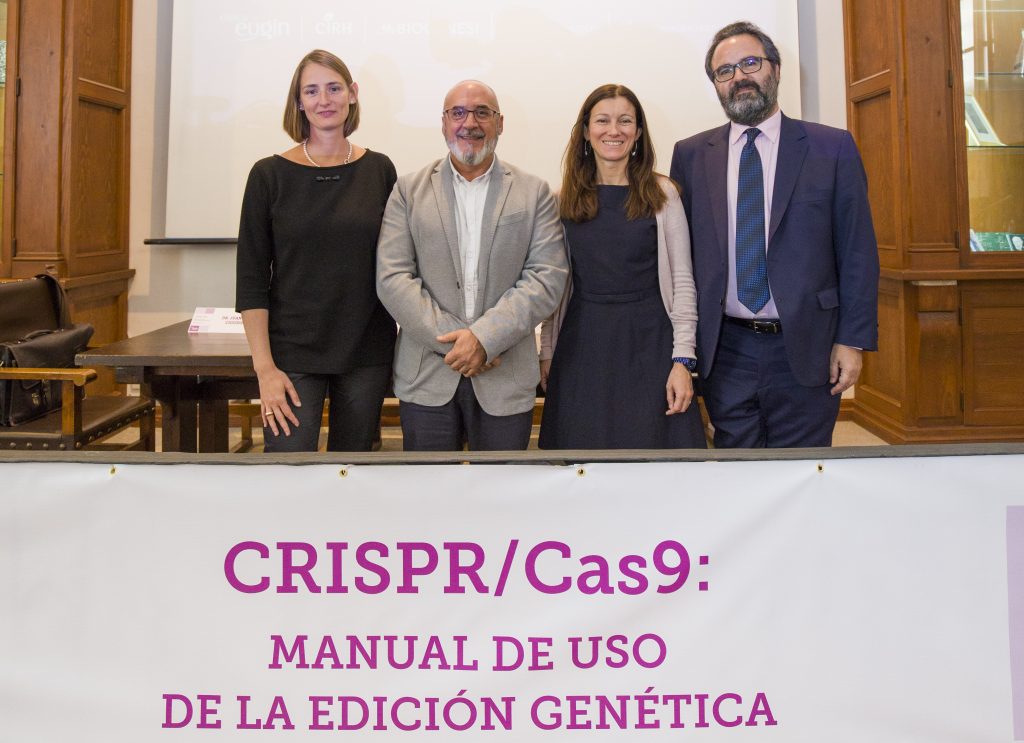Experts call for prudence and an ethical debate on the application of the new CRISPR-Cas9 gene editing system
September 26, 2017
The new gene editing technique allows the DNA of all kinds of cells to be cut very accurately and efficiently in order to correct gene alterations that cause serious diseases
Several Spanish experts in gene editing today concurred in calling for prudence and demanding an ethical debate on the application of CRISPR/Cas9, the new gene editing technique that allows the DNA of all kinds of cells to be cut very accurately and efficiently in order to correct gene alterations that cause serious diseases.
The Madrid College of Physicians hosted the “CRISPR/Cas-9 Gene editing handbook” conference this morning, organised by the Eugin Group. Taking part at the event were: Luis Montoliu, a researcher at the National Biotechnology Centre (CNB-CSIC) and CIBER (Biomedical Research Centre Network of Rare Diseases); Dr. Juan Cruz Cigudosa, president of the Spanish Association of Human Genetics (AEGH); Dr. Paula Río, of the Division of Haematopoietic Innovative Therapies at CIEMAT and CIBER (Biomedical Research Centre Network of Rare Diseases), and Rita Vassena, scientific director of the Eugin Group network of Assisted Reproduction Clinics as well as member of the Executive Committee of ESHRE (The European Society of Human Reproduction and Embryology).
The CRISPR/Cas-9 system has revolutionised genetics and fuelled the hopes of many patients suffering from hereditary diseases. “It’s a change that is here to stay,” said Montoliu, a partner of one of the founding fathers of this technique, the Spanish microbiologist Francisco Juan Martínez Mojica, who has been in the running for a Nobel prize in recent years. For the time being, this system has not yet reached the clinical practice stage, that is to say, used on patients – with the exception of research conducted in China on terminally ill lung cancer patients – although it is being tested successfully in the laboratory on animal and cellular models. And it has even been tested with human embryos generated solely for the purpose of research, as published last summer by a group of scientists from China, South Korea and the United States.
AN APPLICATION WHERE CAUTION NEEDS TO BE EXERCISED
“In regard to CRISPR, the only limit is your imagination,” says Montoliu. Although he himself, and the remaining speakers have managed to set limits to it during the Eugin conference. “I am sure CRISPR will be translated into clinical practice, but we should not do it until we are able to minimize the risks,” he said. As has been shown in several investigations, the application of CRISPR has low effectiveness rates of less than 10 percent. Among other adversities, it has been detected that its application in a particular sequence of the genome causes modifications and undesirable mutations in other genomic sequences, explained Montoliu.
“CRISPR is a geneticists’ dream, it is a great working tool, but it is important to ask ourselves what we want to do with it: Let’s not overshoot the mark,” said Dr. Juan Cruz Cigudosa, president of the Spanish Association of Human Genetics. As Dr. Paula Rio explained, this new genetic editing system gives hope to patients with diseases such as Fanconi’s anaemia, but it is still too early to make the great leap forward to daily clinical practice.
Likewise, Rita Vassena, scientific director of the Eugin Group, has also stressed the need to hold an ethical debate on the application of CRISPR and pointed out that in its application at the experimental phase it raises social and legal dilemmas. In this regard, she highlighted that the embryo research that was published this summer would not have been possible in Spain, nor in practically the rest of Europe, where carrying out research with embryos created expressly for investigative purposes is not allowed.
“We need to improve the effectiveness of CRISPR, apply it gradually and take into account whether there are already alternatives that work,” she said. In this regard, Vassena stressed that in the case of embryos, pre-implantation genetic diagnosis has been in existence for 20 years, which serves to detect genetic diseases in an embryo and thus be able to select the embryos that will lead to a healthy pregnancy.














